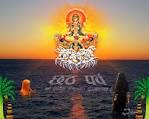Chhath Puja
The Chhath puja festival is celebrate in the month of kartik month according to hindu calendar or in october or november after diwali festival in India.
 The Chhath Puja, which is also known as Dala Chhath, is a significant festival celebrated in Bihar, Uttar Pradesh and in many other states of India as well. The setting sun is worship in this puja. Chhath puja is celebrated most elaborately in Bihar and also in parts of Uttar Pradesh, Jharkhand, West Bengal, Assam, Orissa and even Mauritius, mostly amongst Bhojpuri and Maithali speaking people. The puja is being done since time immemorial with unvarying faith that the Sun God fulfills wishes if the ritual of ‘araghya’ is offered with complete devotion. The people also worship ‘Chhathi Maiya’ on this day.
The Chhath Puja, which is also known as Dala Chhath, is a significant festival celebrated in Bihar, Uttar Pradesh and in many other states of India as well. The setting sun is worship in this puja. Chhath puja is celebrated most elaborately in Bihar and also in parts of Uttar Pradesh, Jharkhand, West Bengal, Assam, Orissa and even Mauritius, mostly amongst Bhojpuri and Maithali speaking people. The puja is being done since time immemorial with unvarying faith that the Sun God fulfills wishes if the ritual of ‘araghya’ is offered with complete devotion. The people also worship ‘Chhathi Maiya’ on this day.
It is said that the Puja is being performed since ancient time by Draupadi, the wife of ‘Pandavas’ king during their exile from their kingdom. One day they were visited by 88 thousand ‘Bhikshuk’ (wandering hermits). As per Hindu customs, the guests are supposed to be treated well and offered food. But the Pandavas barely had enough food for themselves. Seeing the Pandavas in deep trouble, Draupadi asked help from the noble sage Dhaumya, who was pleased with her merits of worshiping the Sun God. Draupadi not only solved their immediate problem but her Sun worship later helped Pandavas regain their lost Kingdom.
The festival connects with purity, devotion and thanks to Sun God as it is the source of life on earth and is observed as he deity who fulfills wishes. The Chhath Puja is done for four days continuously. The people in Bihar specially wait for this festival and celebrate every day in the following way:
Day 1
Nahai Khai- The first day is known as ‘Nahai Khai’ which means Bath & Eat. The ‘Vrati’ or devotees take bath in the sacred river Ganga and take back the holy water to cook offerings (Prasad) at home.
Day 2
Kharna- On the second a complete day fast without water is observed by the devotees. They end their fast after doing the puja in the evening. Offerings or Prasad includes puris (deep-fried puffs of wheat flour) or Rasiao-kheer (rice delicacy). Chapattis and bananas are distributed among family, friends and visitors.
Day 3
Sandhya Arghya or Evening Offering- The third day is also observed with fast without consuming water. The entire day is spent in preparing puja offerings which are made and kept in a tray made out of bamboo. The offerings include Thekua, coconut, banana and other seasonal fruits. The evening rituals are done at the banks of a river or pond or any clean water body. All the devotees assemble and the ‘araghya’ is offered to the setting Sun.
Day 4
Bihaniya Arghya or Morning offerings- As the last day of the auspicious puja, devotees again assemble on the bank of a river or pond to present offerings to the rising Sun. After the offerings are made, devotees break their fast by either eating ginger and sugar or whatever their local tradition holds.
